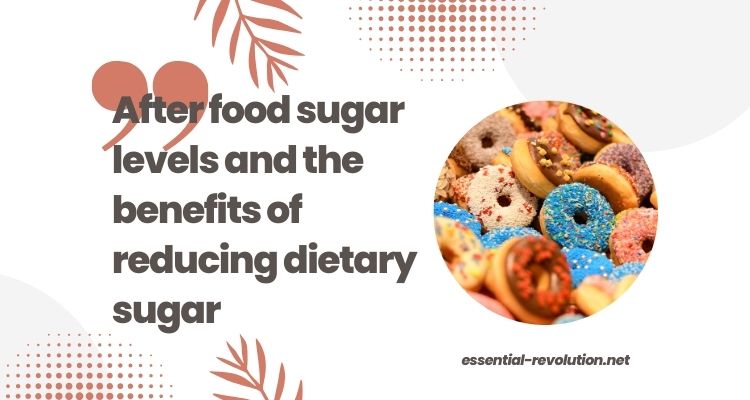Monitoring after food sugar levels is vital for health, so reducing sugar in our diet will improve these levels and our overall wellness.
Understanding After Food Sugar Levels
“After food sugar levels,” or postprandial blood glucose levels, refer to the concentration of glucose in the blood after eating. Typically, blood sugar levels rise after consuming food, especially foods rich in carbohydrates. This rise is normal and is part of the body’s process of digesting and absorbing nutrients. However, consistently high sugar levels can indicate potential health issues, such as prediabetes, type 2 diabetes, or metabolic syndrome. Understanding how these levels work and the importance of maintaining them within a healthy range is crucial for overall health and well-being.
How After Food Sugar Levels Work
When you eat, your body breaks down carbohydrates into glucose, a form of sugar that enters the bloodstream. This process causes blood sugar levels to rise. In response, the pancreas releases insulin, a hormone that helps cells absorb glucose to be used for energy or stored for later use. Ideally, this process keeps sugar levels within a normal range. Typically less than 140 mg/dL two hours after eating for a healthy person. However, if your body doesn’t produce enough insulin or your cells resist insulin’s effects. Glucose can build up in your bloodstream, leading to elevated after food sugar levels.
Factors Influencing After Food Sugar Levels
Several factors can influence after food sugar levels, making them higher or lower depending on the circumstances:
- Type of Food Consumed: Foods high in simple sugars and refined carbohydrates, like white bread, sweets, and sugary beverages, cause a rapid spike in blood glucose levels. In contrast, foods high in fiber, protein, and healthy fats slow the absorption of glucose, leading to a more gradual rise in after food sugar levels.
- Portion Size: Large meals can contribute to higher after food sugar levels because they provide more glucose for absorption. Smaller, balanced meals can help prevent sharp increases in blood sugar.
- Physical Activity: Physical activity helps muscles absorb glucose more efficiently, which can lower after food sugar levels. Regular exercise is particularly beneficial for managing blood sugar levels.
- Insulin Sensitivity: Individuals with insulin resistance, a condition where the body’s cells do not respond effectively to insulin, may experience higher after food sugar levels. This condition is common in people with type 2 diabetes and those with obesity.
- Stress and Sleep: Both stress and lack of sleep can negatively affect blood sugar levels by increasing cortisol. A hormone that can lead to higher blood glucose levels.
Health Risks Associated with High After Food Sugar Levels
Consistently high after food sugar levels pose significant health risks. Over time, elevated blood sugar can lead to various complications, particularly if it remains unmanaged. Some of the key risks include:
- Diabetes: Chronic high after food sugar levels can lead to type 2 diabetes. This is a condition where the body either resists the effects of insulin or doesn’t produce enough insulin to maintain normal glucose levels.
- Cardiovascular Disease: High blood sugar levels can damage blood vessels and nerves. This is increases the risk of heart disease, stroke, and other cardiovascular problems.
- Nerve Damage (Neuropathy): Excessive glucose can damage the small blood vessels that nourish nerves, particularly in the legs. This can lead to tingling, numbness, or pain, a condition known as peripheral neuropathy.
- Kidney Damage (Nephropathy): The kidneys filter waste from the blood. High after food sugar levels can damage this filtering system, leading to kidney disease or even kidney failure.
- Eye Damage (Retinopathy): Elevated blood sugar levels can damage the blood vessels in the retina, potentially leading to blindness.
- Poor Wound Healing: High blood sugar levels can impair circulation and the immune system, slowing the healing of cuts and sores, and increasing the risk of infections.
Benefits of Reducing Sugar Intake
Given the risks associated with high after food sugar levels, reducing sugar in our diet offers numerous health benefits. Here are some of the key advantages:
- Better Blood Sugar Control: Reducing sugar intake helps stabilize after food sugar levels, making it easier to manage blood glucose, particularly for individuals with or at risk of diabetes.
- Weight Management: Excessive sugar consumption is a major contributor to weight gain. Reducing sugar can help control calorie intake, leading to weight loss or maintenance, which is beneficial for overall health and blood sugar management.
- Reduced Risk of Chronic Diseases: Lowering sugar intake reduces the risk of developing chronic diseases such as heart disease, diabetes, and certain cancers. This is because less sugar reduces inflammation, improves lipid profiles, and decreases insulin resistance.
- Improved Energy Levels: High sugar diets can lead to energy crashes after the initial spike in blood glucose. By consuming less sugar and focusing on balanced meals, you can maintain more consistent energy levels throughout the day.
- Better Dental Health: Reducing sugar intake lowers the risk of tooth decay and gum disease, as sugar is a primary food source for the bacteria that cause cavities.
- Enhanced Mood and Mental Health: Studies have shown that high sugar diets can contribute to mood swings, anxiety, and depression. By cutting back on sugar, you may experience more stable moods and improved mental well-being.
Practical Tips for Reducing Sugar Intake
Reducing sugar in your diet doesn’t have to be difficult. Here are some practical tips to help you manage sugar levels more effectively:
- Read Labels: Many processed foods contain hidden sugars under names like sucrose, high-fructose corn syrup, and dextrose. Reading labels can help you identify and avoid these added sugars.
- Choose Whole Foods: Focus on whole, unprocessed foods like vegetables, fruits, whole grains, and lean proteins. These foods are naturally low in sugar and high in nutrients that support stable blood sugar levels.
- Limit Sugary Beverages: Beverages like soda, fruit juices, and energy drinks are often high in added sugars. Opt for water, herbal teas, or beverages with no added sugars.
- Cook at Home: Preparing meals at home allows you to control the ingredients and avoid the hidden sugars often found in restaurant dishes and pre-packaged meals.
- Use Natural Sweeteners: If you need to sweeten your food, consider using natural sweeteners like stevia or monk fruit, which have little to no effect on after food sugar levels.
- Gradual Reduction: If you’re used to a high-sugar diet, reduce your sugar intake gradually. This will help your taste buds adjust and reduce cravings for sugary foods.
- Focus on Fiber: Foods high in fiber, such as vegetables, legumes, and whole grains, help slow the absorption of sugar, leading to more stable after food sugar levels.
- Practice Mindful Eating: Pay attention to hunger and fullness cues, and avoid eating out of boredom or stress. Mindful eating can help you make better food choices as well as reducing unnecessary sugar intake.
The Role of Regular Monitoring
For those concerned about their sugar levels, regular monitoring is crucial. This is especially important for individuals with diabetes or prediabetes. Monitoring your blood sugar levels after meals can help you understand how different foods affect your glucose levels and guide you in making healthier choices. Keeping a food diary and tracking your blood sugar can also provide valuable insights for you and your healthcare provider to develop a personalized plan for managing your after food sugar levels.
Conclusion
After food sugar levels play a critical role in overall health, particularly in the context of preventing and managing chronic diseases like diabetes. So, by reducing sugar intake, you can help stabilize these levels. This will improve your health, and reduce the risk of complications associated with high blood sugar. Adopting a diet rich in whole foods, monitoring your blood sugar, as well as making informed choices about the foods you consume are essential steps towards better health and well-being. Remember, even small changes in your diet can lead to significant improvements in your after food sugar levels, contributing to a healthier, more balanced life.

